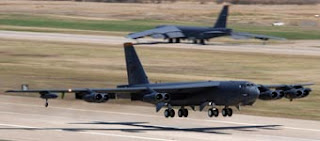B-52s at Minot AFB, North Dakota. A Minot-assigned bomber inadvertently carried five nuclear warheads during a cross-country flight to Barksdale AFB, Louisiana on August 30th, raising concerns about weapons safety and accountability.
There’s something a bit strange about this Drudge-trumpeted story, concerning the Air Force’s “temporary loss” of five nuclear warheads. As reported by the Military Times papers, the warheads were mounted on advanced cruise missiles being flown by a B-52 bomber from Minot AFB, North Dakota to Barksdale AFB, Louisiana. Both Minot and Barksdale are B-52 bases; the movement is part of an effort to decommission 400 of the cruise missiles. The warheads were supposed to be removed before the missiles left Minot, but the error wasn’t discovered until the “Buff” touched down in Louisiana last Thursday.
According to the Times, that left the weapons “unaccounted for” during the 3 1/2 hour flight from North Dakota to Louisiana. However, that’s a specious claim, at best. As Air Force spokesman Lt Col Ed Henry noted, the weapons were in the service’s custody and control at all times. He also reported that all other nuclear weapons at Minot have been accounted for.
What’s more disconcerting is the (apparent) break-down in the nuclear chain of custody. Readers of my profile know that I spent portions of my career around nukes, both as an operational intelligence officer and a targeteer. My duties didn’t involve the actual handling or loading of those weapons, but you learned quickly that nukes are governed by a completely different set of rules, for obvious reasons. Those regulations are strictly enforced, with “no tolerance” for mistakes.
First, nuclear weapons are segregated from “ordinary” munitions, with additional layers of security and access control. All personnel involved in the protection, storage, handling and loading of the weapons are carefully vetted through the military’s Personnel Reliability Program (PRP). Anyone whose loyalty, judgment or stability comes into question loses their PRP certification, and they’re no longer allowed to work around nuclear weapons.
Other safeguards are built into the system as well. There’s a very tight chain of control; the device is literally “signed for” at every step of the journey from the weapons storage area to the aircraft, and the two-man “rule” is strictly enforced. An individual pilot or load crew member is never allowed to “control” the weapon on the ground. In combat, the pilot of a single-seat fighter would be permitted to launch with a nuclear weapon–and use it in combat–but only if the pilot was certified for the mission, and the “tasking” had been properly authenticated through the chain of command, beginning with the President, or in tactical scenarios, the theater commander–under authority granted by the POTUS.
MSNBC is now reporting that a B-52 squadron commander at Minot has been relived of his duties, because the service has “lost confidence” in his ability to handle nuclear weapons. That move is hardly surprising, given the obvious emphasis that the Pentagon places on nuclear safety and control. And, it’s likely that other heads will roll as the Air Force continues its investigation. As we noted in the preceding paragraphs, the movement, loading and protection of nuclear weapons is a carefully regulated process, involving a number of specialists. All could be found culpable in this incident.
But that still doesn’t explain how nuclear-tipped cruise missiles were loaded onto a B-52, flown 1450 miles across the United States, and the mistake wasn’t discovered until the bomber reached its destination in Louisiana. With most of the Advanced Cruise Missile fleet (AGM-129) is being retired from operational service, we can assume that Minot crews had been through this drill before. Remove the warhead from the missile, then fly the inert weapon to Barksdale for decommissioning. Retiring the warhead–if that’s part of the plan–entails a separate (and completely different) process which does not require a B-52 flight.
Given the elaborate safeguards, security procedures and chain-of-control associated with nuclear weapons, it’s difficult to fathom how five warheads made their way onto that Buff and they weren’t noticed until it arrived at Barksdale. It would be interesting to know how the 5th Bomb Wing (Minot’s B-52 unit) fared on its last Nuclear Surety Inspection (NSI), which evaluates unit procedures for controlling, handling and safeguarding those weapons.
Something tells me the NSI team will be returning to Minot very soon, and they’ll probably evaluate a wing with a new leadership team. Wing commanders who fail their NSI are usually fired; allowing one of your aircraft (and crews) to “unwittingly” carry five nuclear warheads across country is an equally serious offense. It will be interesting to see if the wing’s current commander survives this embarrassing incident.
***
Ironically, the Minot episode reminds us that the nuclear “sabre” was once brandished more openly. During much of the Cold War, Strategic Air Command B-52s (and other bombers) flew “airborne alert” missions, with nuclear weapons onboard. The aircraft loitered near departure points over the North Atlantic (and elsewhere), ready to launch nuclear strike missions against the Soviet Union upon direction from the National Command Authority (NCA). Airborne alert came to an end after a pair of highly-publicized accidents involving B-52s carrying nukes.
In the first event, a bomber collided with a KC-135 tanker during an in-flight refueling off the coast of Spain in January 1966, touching off a frantic search for the B-52’s four nuclear weapons, which fell into the ocean. The last of the weapons was recovered 80 days later. In 1968, another Buff crashed during an emergency landing at Thule AB, Greenland, spilling radioactive debris across the ice and snow. Hundreds of airmen worked for months cleaning up the radioactive waste. After that, SAC’s airborne alert program came to an end.



